Zespół Laboratoriów Badawczych i Wzorcujących GIG-PIB
- Investigation into susceptibility of coals to spontaneous combustion
- according to PN-93/G-04558 standard
- using the calorimetric method
- Determination of critical conditions for spontaneous combustion of coal in the seam
- Development of a model of gas emission from the heated fragment of coal deposit
- Monitoring of fire hazard level in coal mines based on the precise chromatographic analysis (trace content of carbon monoxide, ethylene, propylene, acetylene and hydrogen and oxygen isotopes) of gas samples together with a current risk assessment
- Prediction of fire hazard in mines together with a risk assessment
- Monitoring of the process of fire suppression and cooling of heated coal mass in sealed off workings based on the precise chromatographic analysis of gas samples
- Determination of conditions for safe opening and ventilation of the workings sealed off due to fire hazard
- Elaboration of the principles for effective fire prevention:
- determination of minimum longwall advance on grounds of fire hazard
- selection of an inert gas
- selection of means that limit air flow through the gobs
- elaboration of principles for prevention based on the use of inhibitors of spontaneous combustion process
- Selection of the equipment and measures necessary for extinguishing fires
- Extinguishing of underground fires by means of active and passive methods
- Investigation into spontaneous combustion of various materials
- Organization and completion of equipment for laboratories performing research relating to:
- early detection of endogenous fires based on the trace content of selected gases in air samples
- susceptibility of coals to spontaneous combustion
- Determining the rules for fire detection in tunnels
Since 1998 we have been accredited by the Polish Centre for Accreditation (Accreditation Certificate AB 005).
Nr certyfikatu: AB 005
Kierownik:
e-mail: adudzinska@gig.eu
telefon: 32 259 21 27
- testing of steel ropes, and new rope solutions;
- rope selection;
- research on the control and certification examinations of construction elements of transport equipment including mining link chains;
- certification testing of construction elements and the
- power equipment in accordance with the standard PN-EN 61284 and of wires, CEI IEC 62219:2002, PN-IEC 1089:1994, PN-EN 50182:2002, IEC 62420:2008, PN-EN 60889,:2002, PN-EN 50189:2002, PN-EN 60889:2002, PN-EN 50183:2002;
- geometric measurements of excavation shafts and constructions using laser scanning;
- tests of cable railways.
Nr certyfikatu: AB 005
Kierownik:
e-mail: bkubis@gig.eu
telefon: 32 259 23 67
- station tests of door-frames of roadway supports;
- examination of the accessories of roadway supports (shackles, struts, welded nets, cladding, support footings, etc.);
- tests of stands and hydraulic servomotor (statics and dynamics);
- testing of friction prop;
- tests of valves and valve blocks;
- tests of roof-bars and bases;
- tests of high pressure, hydraulic wires and hoses;
- tests of idlers;
- tests of large-diameter pipes made of any material (tightness of connection, peripheral stiffness);
- strength tests of elastomeric bearings (test of the non-dilatational deformation module, shear adhesion test and compression test);
- testing of structural components at dynamic loads (rail buffers, chains, etc.).
Nr certyfikatu: AB 005
Kierownik:
e-mail: sbaranowski@gig.eu
telefon: 32 259 27 57
accredited by the Polish Centre for Accreditation under No. AB 005, conducts testing and provides consulting in a scope of:
- accredited tests of spacers for overhead conductors:
Visual examination | PN-EN IEC 61854:2020-11 |
Verification of dimensions, materials and mass | PN-EN IEC 61854:2020-11 |
Corrosion protection test | PN-EN IEC 61854:2020-11 |
Clamp slip test | PN-EN IEC 61854:2020-11 |
Clamp bolt tightening test | PN-EN IEC 61854:2020-11 |
Compression and tension tests | PN-EN IEC 61854:2020-11 |
Flexibility tests | PN-EN IEC 61854:2020-11 |
- accredited tests of optical ground wires (OPGW):
Tensile performance test | PN-EN 60794-1-21: 2015-07 |
Stress-strain test | PN-EN 50182:2002
PN-IEC 1089:1994/A1:2000 – Annex B |
Breaking strength test | PN-EN 60794-4-10:2015-03 p. 8.3.4
PN-EN 50182:2002 p.6.4.8 |
Water penetration test | PN-EN 60794-1-22:2018-04 p. 5 method F5B |
- accredited creep test of stranded conductors in accordance with EN 61395:2002,
- determination of stress at 1% extension of steel wires of overhead conductors in accordance with PN-EN 50189:2002 and PN-EN 61232:2002,
as well as other mechanical tests of power grid components included in standard series PN-EN 60794, PN-EN IEC 61854, PN-EN IEC 61897 and PN-EN 61284.
All PN- standards are direct equivalents of international EN and IEC standards.
We undertake testing specified by client`s methodology or industry standards. We resolve problems with testing and assessment – contact us!
Nr certyfikatu: AB 005
Kierownik:
e-mail: apawlowski@gig.eu
telefon: 32 259 27 91
Laboratory of Air Dustiness Measurements (KD-2.2) is a part of the Group of Testing and Calibration Laboratories of the Central Mining Institute accredited by the Polish Accreditation Centre (PCA) in Warsaw.
Since 1998 Laboratory has been accredited as a calibration laboratory, number of accreditation - AP 006, website: https://www.pca.gov.pl/akredytowane-podmioty/akredytacje-aktywne/laboratoria-wzorcujace/AP%20006,podmiot.html
The accreditation includes calibration of dust samplers and aspirators:
- Barbara 3Adust sampler with flow rate of 4,5 - 5,5 dm3/min,
- personal dust sampler CIP-10 with flow rate 9,8 – 10,2 dm3/min,
- aspirators: SKC, AP 2000Ex, Gilian and others with the flow of 1,7 - 2,4 dm3/min.
The laboratory is also accredited as a testing laboratory, number of accreditation - AB 005, website: https://www.pca.gov.pl/akredytowane-podmioty/akredytacje-aktywne/laboratoria-badawcze/AB%20005,podmiot.html since 2006 in the scope of:
- measurements of dust concentration at workplaces,
- measurements of the dust concentration of the most dust-generating technological process (worst case),
- selection of personal respiratory protection of an employee at his workplace,
- measurement and analysis of respirable fibres in air at workplaces or in an environment,
- measurement and analysis of respirable asbestos fibres in air at workplaces or in an environment,
- analysis of grain size distribution of airborne dust (outside the scope of the accreditation).
The Laboratory also carries out research outside the scope of the accreditation:
- effectiveness and correctness of dust collection equipment with the separate ventilation system of mines built in mine roadways,
- internal and external sprinkler systems installed on the shearers and the heading machines in terms of effectiveness of control of mechanical sparks capable to ignite methane and reduction of airborne dust,
- strength tests of suction and discharge flexible lutes.
Participation in projects:
The Laboratory is a member of the consortium that performs research in the European Project ROCD of the Fund for Coal and Steel (RFCS) “Reduction of risk associated with exposure to coal dust”.
More important research and development activities:
- tests and evaluation of the effectiveness of methane and spark extinguishing generated by shearers and the heading machines in accordance with Polish legal requirements,
- calibration of personal dust samplers CIP-10, Barbara 3A and aspirators in the calibration laboratory (AP 005) in accordance with the procedures accredited by the Polish Centre for Accreditation (PCA) in Warsaw,
- determination of respirable fibres in dust, in accordance with the procedures accredited by the Polish Centre for Accreditation (PCA) in Warsaw,
- quantitative and qualitative microscopic analysis of dust samples for the presence of coke collected in areas where hazardous event happened.
Nr certyfikatu: AB 005, AP 006
Kierownik:
e-mail: tpindel@gig.eu
telefon: 32 3246 516
- Determination of methane content using direct method.
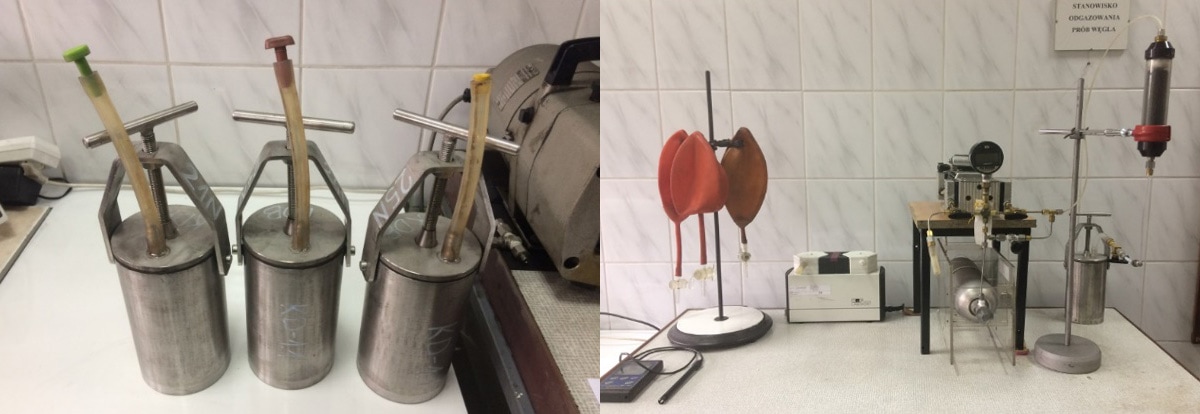
Coal degassing stand using the MOD-2
- Desorption tests using United States Bureau of Mines (USBM) method.
Tests include:
- Determination of lost gas, desorbing gas and residual gas,
- Determination of the composition of desorbing and residual gas by gas chromatography,
- Determination of final methane content.
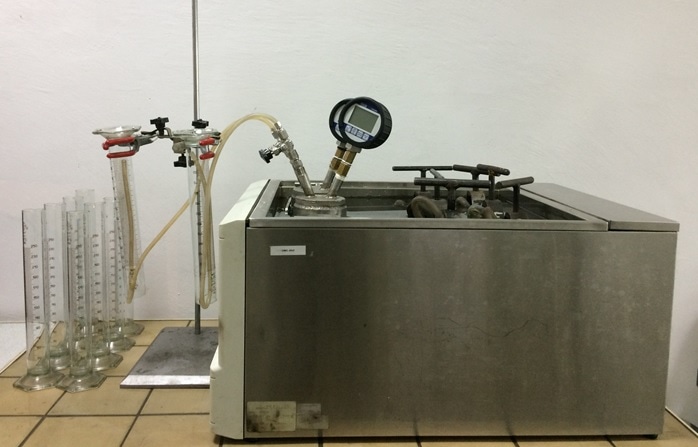
Stand for desorption tests (USMB)
- Determination of physical and chemical parameters of solid fuels:
- ash content (A),
- expiring moisture (Wex),
- hygroscopic moisture (Wh),
- moisture in the analitical sample (Wa),
- total moisture (Wt)
- voltalite matter (Vdaf),
- density by helium pycnometry (dr). - Research on the desorption of methane from coal under variable hydrostatic pressure conditions.
- Determining coefficient of rocks’ conciseness (fz).
- Chromatographic analysis of mine air: O2, N2, H2, CO2, CO, CH4, C2H6, C2H4.
- Chromatographic analysis of the following gases: O2, N2, H2, CO2, CO, CH4, C2H6, C2H4, C2H2, C3H8, C3H6, n- C4H10.
- Detection of flammable and toxic gases hazardous concentrations: O2, CO2, CO, CH4, H2S, SO2, NO2, NO.
- Determination of sorption parameters:
- effective diffusion coefficient (De),
- sorption capacity (a),
- sorption capacity calculating into daf (adaf),
- sorption half-time (t0,5),
- determination of sorption isotherms based on Langmuir isotherm model.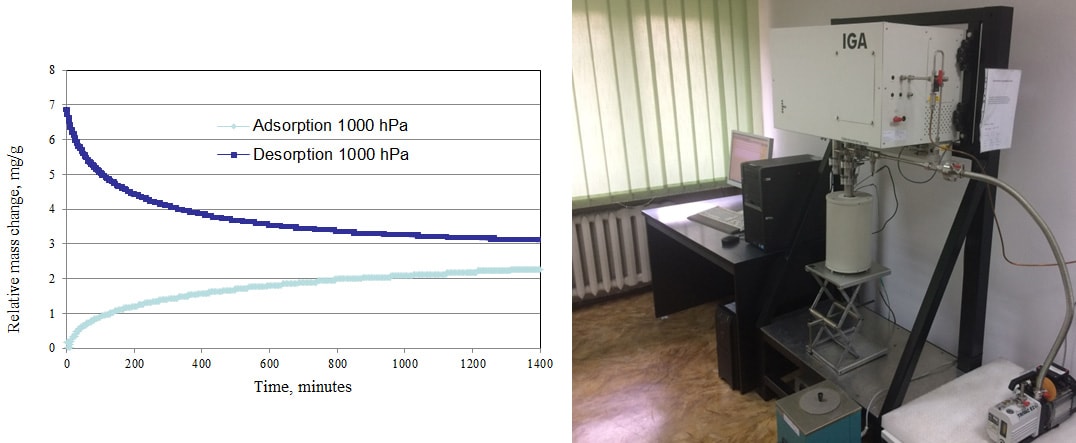
Methane sorption and desorption changes tests using gravimetric
etting IGA-001 to determine sorption parameters of coal
Nr certyfikatu: AB 005
Kierownik:
e-mail: mkarbownik@gig.eu
telefon: 32 3246 503
Centrum realizuje prace badawcze i rozwojowe w obszarze radiometrii, dozymetrii radiacyjnej, ochrony radiologicznej i radioekologii. Centrum, na mocy Rozporządzenia Rady Ministrów z 17 grudnia 2002 jest tzw. Placówką Specjalistyczną, prowadzącą ciągły monitoring skażeń promieniotwórczych. Centrum jest członkiem sieci ALMERA, koordynowanej przez IAEA (Międzynarodową Agencję Energii Atomowej). Centrum posiada akredytację PCA na wykonywane badania oraz zatwierdzenie Powiatowego Inspektora Sanitarnego w zakresie badań wody przeznaczonej do spożycia.
Zakres działalności zakładu:
- Oznaczanie stężenia izotopów promieniotwórczych w próbkach stałych i ciekłych metodami spektrometrii promieniowania gamma, ciekłoscyntylacyjnej (LSC), spektrometrii promieniowania alfa:
Oznaczane izotopy: 226 Ra, 228Ra, 222Rn, 228Th, 210Pb, 210Po, 234U, 235U, 238U, 3H, 241Am, 134Cs, 137Cs, 60Co, 131I, 7Be i inne.
- woda przeznaczona do spożycia, wody mineralne i lecznicze i inne;
- materiały budowlane;
- odpady przemysłowe i inne;
- gleba, osady, skały;
- próbki środowiskowe;
- żywność, pasze i inne materiały biologiczne.
- Pomiary dawek promieniowania (dozymetria indywidualna i środowiskowa):
- promieniowania rentgenowskie, gamma, beta, neutronowe;
- energia potencjalna alfa pochodnych radonu.
- Badania radonu (Rn-222):
- stężenie radonu w powietrzu (m.in. w budynkach);
- ekshalacja radonu z gleby.
- Badania aerozoli (wyznaczanie rozkładu ziarnowego w zakresie 3 nm - 20 μm).
- Kontrola szczelności izotopowych źródeł promieniowania.
- Technologie i wiedza ekspercka:
- Metody usuwania izotopów radu z wody.
- Rewitalizacja terenów skażonych promieniotwórczością.
- Bezpieczne zagospodarowanie odpadów o podwyższonej promieniotwórczości.
- Identyfikacja i charakteryzacja skażeń promieniotwórczych.
- Poznaj pełen zakres badań.
Nr certyfikatu: AB 005
Kierownik:
e-mail: mwysocka@gig.eu
telefon: 32 259 28 14
Nr certyfikatu: AB 005, AP 006
Kierownik:
e-mail: tpindel@gig.eu
telefon: 32 3246 516
CALIBRATION:
Calibration of mechanical vibration measuring instruments within the Scope of Accreditation No AP 006 granted by PCA:
- calibration of vibration transducers in accordance with the ISO 16063-21 standard in the frequency range of 0.5 Hz - 10 kHz,
- calibration of vibrometers - measuring instrumentation of human response to vibration in accordance with the PN-EN ISO 8041-1:2017 standard,
- calibration of vibration calibrators in the frequency range of 15 Hz
-2 kHz, - calibration of machine vibration meters in accordance with the ISO 2954 standard in the frequency range of 10 Hz
-2 kHz;
Calibration of instruments for acoustic measurements within the Scope of Accreditation No AP 006 granted by PCA:
- calibration of sound level meters in accordance with the PN-EN 60651 and PN-EN 60804 standards,
- calibration of sound level meters in accordance with the PN-EN 61672 standard,
- calibration of sound calibrators - comparative method in accordance with the PN-EN 60942 standard,
- calibration of sound calibrators - insert voltage calibration method in accordance with the PN-EN 60942 standard,
- calibration of octave and 1/3 octave band filters in accordance with the PN-EN 61260 standard,
- calibration of measurement microphones using the LS class calibrator method and insert voltage calibration method - in accordance with the PNEN 61094 standard;
Calibration of vibration measuring instruments beyond the scope of the PCA accreditation:
- calibration of impact hammers according to the manufacturer’s instructions in the frequency range 10 Hz - 10 kHz,
- calibration of laser vibrometers in accordance with the ISO 16063 standard in the frequency range 0.5 Hz - 10 kHz,
- calibration of palesthesiometer (measuring instruments for vibrotactitle perception thresholds) in accordance with the ISO 13091-1: 2001: 2006 standard,
- calibration of signal recorders / analysers / signal conditioning systems.
Summary of the offered calibration services is presented in the Tables below:
Calibration within the Scope of Accreditation No AP 006
Object | Norm | Frequency range |
Vibration transducers (acceleration and velocity) | ISO 16063-21:2003 | 0,5 Hz – 10 kHz |
Vibrometers - measuring instrumentation of human response to vibration | PN-EN ISO 8041-1:2017 | 2 Hz – 800 Hz |
Vibration calibrators | ISO 16063-21:2003 | 15 Hz ÷ 2 kHz |
Machine vibration meters | ISO 2954:2012 | 10 Hz – 2 kHz |
Measuring microphones | PN-EN 61094-6:2005 | 20 Hz – 20 kHz |
Sound calibrators using the standard microphone method | PN-EN 60942:2005 | 250 Hz, 1 kHz |
Comparative sound calibrators | PN-EN 60942:2005 | 250 Hz, 1 kHz |
Sound level meters | PN-EN 60654:2002 (U) PN-EN 60804:2002 (U) PN-EN 61672-3:2007 PN-E 61672-3:2014-03 | 20 Hz – 20 kHz |
Band filters with octave width or part of an octave | PN-EN 61260:2000 | 20 Hz – 20 kHz |
Calibration outside the Scope of Accreditation No AP 006
Object | Norm | Frequency range |
|---|---|---|
Modal hammers | As indicated by the manufacturer | 10 Hz – 10 kHz According to the data manufacturers' catalogues |
Laser vibrometers | ISO 16063-41:2011 | 0,5 Hz – 15 kHz |
Signal recorders Analyzers Signal conditioning systems e.g. SCADAS, PULSE, Vibration Research, ADRE | ISO 2954:2012 | 0,5 Hz – 15 kHz |
RESEARCH:
Acoustics
- indoor and outdoor environmental noise - the influence of traffic and/or industrial noise on open land areas –within the Scope of Accreditation No AB 005 granted by PCA,
- digital noise maps preparation using GIS and GPS technology –within the Scope of Accreditation No AB 005 granted by PCA,
- environmental impact assessment of industrial sites, transport routes, public utility facilities and others concerning vibroacoustic hazards –within the Scope of Accreditation No AB 005 granted by PCA,
- vibroacoustic forecasting for investments and sites undergoing modernisation at various stages –within the Scope of Accreditation No AB 005 granted by PCA,
- in situ testing of the screening efficiency in areas protected by acoustic barriers
-within the Scope of Accreditation No AB 005 granted by PCA, - tests of the impact of noise caused by sources located indoor and outdoor on people staying in residential, public and others buildings,
- determination of sound power levels and sound energy levels of noise sources using sound pressure - engineering methods for an essentially free field and survey method using an enveloping measurement surface, over a reflecting plane in accordance with PN-EN ISO 3744: 2011 and PN-EN ISO 3746: 2011 standards - within the Scope of Accreditation No AB 005 granted by PCA,
- testing of noise emission of machines at their place of operation.
Vibration
- testing of the impact of mechanical vibrations transferred through the ground on the construction of buildings and other structures in accordance with standard PN-B-02170:2016 - within the Scope of Accreditation No AB 005 granted by PCA,
- diagnosis of the technical state of buildings and engineering structures using the modal and wavelet analysis,
- tests of the impact of mechanical vibration on people in buildings in accordance with the PN-B-02171:2017 standard - within the Scope of Accreditation No AB 005 granted by PCA,
- quality assessment of rock bolt support systems in coal mines, tunneling and building reinforcement,
- environmental testing of technical objects, devices and apparatus with weight, up to 120 kg using the vibration exciter
-according to standard PN-EN 60068-2-6:2008 - within the Scope of Accreditation No AB 005 granted by PCA, - tests of the resistance of technical objects to vibrations in accordance with the requirements specified by the customer,
- tests of resonant frequencies of technical objects,
- tests of the impact of mechanical vibration on people within the framework of research projects.
Electrostatics
- material, product and equipment tests using standard methods,
- personal protective equipment electrostatic property evaluation,
- electrostatic protection,
- formulating opinions and interpretations based on test results,
- work related to the antistatic treatment of plastics,
- EPA (ESD Protected Area) implementation,
- audits concerning EPAs and electrostatics,
- destructive testing related to electrification,
- tests under a broad range of climatic conditions in a climatic chamber,
- tests of the electrical and electrostatic earthing of installations and facilities.
Thermovision
- tests of the thermal insulation of buildings and heating pipelines;
- tests of the thermal state of industrial waste dumps, especially mining, and coal storage sites;
- tests of the thermal state of machines use in technical, energy and horizontal mining transport equipment;
- human examinations for medical diagnostic purposes;
- early detection of endogenous fires in underground mines using pyrometers;
- high-current power connector efficiency tests.
Meteorological station www.meteo.gig
Presentation of current weather conditions from the meteorological station located within the Central Mining Institute.
Nr certyfikatu: AB 005, AP 006
Kierownik:
e-mail: abramorska@gig.eu
telefon: 32 259 21 62
Equipment:
- Instruments for determining geometrical quantities
- VICAT HDT
- Strength machines
- Thermal baths
- Climate chambers
- Weight plastometer
- Charpy impact hammer
- A device for testing the impact strength of pipes using the falling weight method
- Device for testing abrasion of pipes
- Stand for testing variable pressure cycles
- Creep testing machine
- Weights
- Incubator
- Cyclic temperature changes and external load of piping testing device
- Deformation sensors
- Shore hardness tester
- Muffle furnace
- Stethoscope optical microscope
- Electrofusion welder
- Injection
- Twin screw extruder
- Dynamic mixer
- Vibration table
- 3D printers
- CNC milling machine
Nr certyfikatu: AB 005
Kierownik:
e-mail: akulawik@gig.eu
telefon: 32 259 24 93
Equipment:
- Testing chamber according to UL-94
- Stand for flame tests
- Stand for the friction test
- Cone calorimeter + flue gas FTIR analyzer
- TGA thermogravimeter
- DSC differential scanning calorimeter
- Oxygen index stand
- Test stand according to PN-EN ISO 11925-2
- Test stand according to PN-EN ISO 1182
- Model adit PN-93/C-05013 point 2.4
- Test stand for the determination of thermal decomposition products
- Hot surface test stand PN-C-05019
- Test stand for the determination of Cleveland flash point
- Propane grate PN-EN 12881-1. Method C
- Pest stand (glowing / hot wire) according to PN-EN 606952
- Spectrophotometer Pharo 300
Additionally
- Foil press
- Granulator
- pH / conductivity meter
Nr certyfikatu: AB 005
Kierownik:
e-mail: kwypior@gig.eu
telefon: 32 3246 540
Zakład Oceny Jakości Paliw Stałych
The Department of Solid Fuels Quality Assessment has worked continuously since 1945.
Its highly skilled personnel, modern equipment and efficient management system ensure the accuracy, timeliness and reliability of the performed tests.
The Department conducts tests of solid fuels, solid biofuels, solid secondary fuels, mixtures of solid biofuels and solid secondary fuels with solid fuels and of waste (code 10 01 01, 10 01 02, 10 01 15, 10 01 17, 10 01 80, 10 01 82).
The Department has:
- the Certificate of a Research Laboratory Accreditation issued by the Polish Centre for Accreditation, confirming the meeting of the requirements of the PN–EN ISO/IEC 17025:2018-02 standard (accreditation number: AB 069);
- the Certificate of Approval issued by Lloyd's Register (Poland) Sp. z o.o. on behalf of Lloyd's Register Quality Assurance Limited, certifying that the Quality Management System is in compliance with the ISO 9001:2015 standard (Certificate of Approval number: ISO 9001-0052768).
The Department of Solid Fuels Quality Assessment provides services in the field of:
- Physical-chemical analyses of deposit and sortment hard coals as well as of other solid fuels, such as lignite, coke, semi-coke, hard coal and lignite briquettes, solid biofuels, solid secondary fuels and mixtures of solid biofuels and a solid secondary fuels with coal;
- Technical analysis:
- transient moisture determination Wexr,
- moisture determination in the analytical sample Wa,
- calculating the total moisture Wtr (using Wexr and Wa),
- determination of ash content Aa,
- determination of total sulphur content Sta,
- determination of total sulphur content with the Eschka method,
- determination of combustion heat and the calorific value Qsa, Qir,
- Physical-chemical analysis:
- determination of volatile elements Va,
- calculation the content of combustible elements (using Wa and Aa),
- actual density determination dra,
- calculation of the fixedcarbon Cfixed indicator (using the Wa, Aa and Va),
- Hardgrove's indicator of grinding susceptibility determination HGI,
- determination of the ash characteristic fusibility temperature,
- determination of the maximum capacity of the moisture absorption Wmax,
- Elemental analysis:
- determination of total carbon content Cta,
- calculation of the organic carbon content (using Cta and WCO2),
- determination of total hydrogen content Hta,
- determination of the nitrogen content Na,
- calculation of the oxygen content Oda (using the Wa, Aa, Cta, Hta, SCa),
- determination of the carbonate CO2 content WCO2,
- calculation of the carbonate carbon content WC (using WCO2),
- determination of sulphate sulphur (VI) SSO4a,
- determination of the pyrite sulphur content Spa,
- calculation of organic sulphur in hard coal and lignite Soa (using Sta, SSO4a and Spa),
- determination of the ash sulphur content SAa (also using the Aa),
- calculation of combustible sulphur SCa (using the Sta and SAa),
- determination of the chlorine content Cla,
- determination of the biodegradable fraction content.
- Petrographic analysis :
- determination of the vitrinite reflectance Ro,
- determination of the composition of groups of macerals and of mineral substance.
- Analysis of coking parameters:
- determination of the capacity of caking with the Rogi method RI,
- Gray-King's determination of the type of coke GK,
- determination of the dilatometric indicators by Audibert-Arnu,
- determination of the swelling indicator SI,
- determination of the status plastic indicators according to Gieselera-Hoehnego,
- determination of plastometric properties using a plastometer with a fixed torque rotation,
- determination of plastometer icindicators according to Sapożnikow,
- no pressure of the Pmax relaxation.
- Coal type analysis.
- The determination of the international classification of coals.
- The designation of the international code.
- Assessment of the composition and properties of ash from coals.
- Analysis of ash and slags form utility boilers.
Other specialist tests outside accreditation:
- Composition of maceral groups and mineral substance with the semifusinite content designation.
- Maceral composition.
- Composition of microlithotype, carbominerite and minerite.
- Maximum and minimum vitrinite reflectacne (determination of anisotropy)Rmax.
- Designation of ash sulphur content in solid biofuels and solid secondary fuels.
- Designation of sand content.
- Designation of losses at calcination.
- Total moisture content with the distillation method.
- Apparent density.
- Forecast of coke strength with the Schapiro method for one-component coal.
- Effectiveness of low-temperature carbonization products.
- Grain analysis with the screening method.
- Density analysis.
- Free calcium oxide content.
- Designation of the transport susceptibility index.
- Bright coal content.
- Stone content in coal.
- Magnetic weights analysis.
- Heat capacity of solids.
- Spontaneous combustion indicator.
- Angle of repose.
- Nitrogen content with the Kjeldahl method.
- Bulk density in coal, in coke from coal, in solid biofuel and in solid secondary fuel.
- Enrichment tests.
- Laboratory sieve checks.
- Production and distribution of standard and control samples.
- Analyses of solid fuels and furnance waste for the purpose of CO2 emissions;
- Waste analyses (code: 10 01 excluding 10 01 09);
- Performing analyses for arbitration samples in disputes;
- Comprehensive tests organization, in cooperation with other laboratories of the Central Mining Institute;
- Perforing proficiency testing by interlaboratory comparison of coal, solid biofuel and solid secondary fuels.
The Department of Solid Fuels Quality Assessment offers:
Training in the system of monitoring and controlling the quality of solid fuels in accordance with the proposed new legal acts;
- The training covers issues related to the law of 5 August 2006 on the system of monitoring and controling the quality of fuels (Dz. U. Nr 169, poz. 1200 - Journal of Laws No 169, item 1200) and with the following regulations:
- Regulation of the Minister of Economy on quality requirements for solid fuels;
- Regulation of the Minister of Economy on collecting samples of solid fuels;
- Regulation of the Minister of Economy on the methods of testing the quality of solid fuels.
- The training is intended for people interested not only in the monitoring of solid fuels, but also in their control and methods of collection, preparation and examination of samples of solid fuels in accordance with the current, latest regulations.
- Trainings on the rules of storage, maintenance and fuel stock control in enterprises — privileges and regulatory experience;
- Trainings on the impact of factors arising from the quality of the fuel on the combustion process;
- Training for sample collectors in the field of technical standards PN and ISO;
- Practical training on research stations for laboratory staff and quality control departments;
- The aim of the practical training at research stations:
- Certification of samplers.
The Certification Body of the Central Mining Institute on 23 November 2011, has been accredited by the Polish Centre for Accreditation (AC 145) in the area of certification of the competence of samplers, for sampling the following:
- hard coal,
- lignite
- coke, semi-coke,
- solid secondary fuels,
- solid biofuels,
- furnace waste.
Nr certyfikatu: AB 069
Kierownik:
e-mail: prompalski@gig.eu
telefon: 32 259 26 09
Zakład Monitoringu Środowiska
The Laboratory has many years of experience in testing elements of the natural environment, state of the environment, industrial products and wastes, etc. It is the first laboratory of waste testing in Poland which has been accredited by the Polish Centre for Accreditation.
The Laboratory conducts work within the framework of own, targeted and ordered research projects regarding new development and adaptation of existing analytical methods for analysing environmental samples and for analysing samples related to the industry.
The scope of activity of the Laboratory of Solid Waste Analyses includes various types of research objects, such as environmental samples (lands/soils), industrial solid wastes, solid fuels, building materials, filter beds and materials for contact with drinking water).
It should be added that expertise, opinions, assessments for industry, mining and environmental services are carried out in cooperation with the Division of Ecological Researches and the other laboratories of the Department of Environmental Monitoring GIG, in the field of, among others, soil and land pollution, environmental impact, or the use of wastes, e.g. on the surface of the earth and in the underground mining excavations.
The competent and experienced staff, application of the principles of professional laboratory practice and modern test and measurement facilities enable a wide range of tests, such as physicochemical analysis, technical analysis, determination of basic composition and trace elements as well as rare earth metals.
Samples delivered to the Laboratory should be protected against the possibility of moisture or secondary contamination (a sealed foil bag, jar, plastic container, etc.) and provided with a label containing basic identification data. The parcel should also contain the order (letter) for testing.
As the amount of sample delivered to the Laboratory and the time of analysis is due to the set / predicted scope of tests, the Customer should agree in advance the sample size with the Head of Unit.
 |  |  |
The staff employed in the Lab of Ecological Analyses have knowledge supported by high qualifications and many years of experience. The team consists of specialists in geology, hydrogeology, physics, and environmental protection, having the powers of experts from the list of the Silesian Voivode in the field of nature protection, preparing environmental impact assessments, as well as the powers of the Minister of the Environment in the field of hydrogeology.
The Lab of Ecological Analyses carries out fieldwork consisting of, among others, collecting environmental samples, testing the flow of watercourses and surface soil filtration coefficients, testing the slope stability. Sampling and transport of samples are carried out throughout Poland. A team of experienced staff collecting samples has the specialized equipment, which guarantees high quality of services provided in all field conditions.
The Lab of Ecological Analyses offers to monitor, in accordance with Polish law, of:
- ground and surface waters, as well as sewage,
- industrial, urbanized, agricultural and forest areas,
- landfills,
- mining waste disposal facilities,
- municipal and industrial sewage treatment plants,
- municipal sewage sludge and agricultural soils.
Division of Ecological Researches prepares a number of assessments, expertise, and opinions.
We guarantee participation and assistance in the process of obtaining administrative decisions resulting from legislation.
Division of Ecological Researches uses modern equipment for field testing and modern software to interpret and visualize the measurement results.
The Laboratory conducts research and service activities in the broadly understood mineral engineering. It covers issues related to the identification of the chemical and mineral composition as well as testing the technological characteristics of minerals and wastes.
The Laboratory is equipped with a modern digital scanning electron microscope Hitachi model
SU-3500N with an EDS attachment and a sputter, as well as an analyser of size, shape, and number of particles Morphologi G3S-ID, made by Malvern, with a Raman spectroscopy attachment for analysis to identify the chemical composition.
We carry out technological works aimed at defining and optimizing technical and technological conditions for valorisation and obtaining commercial products from minerals and wastes.
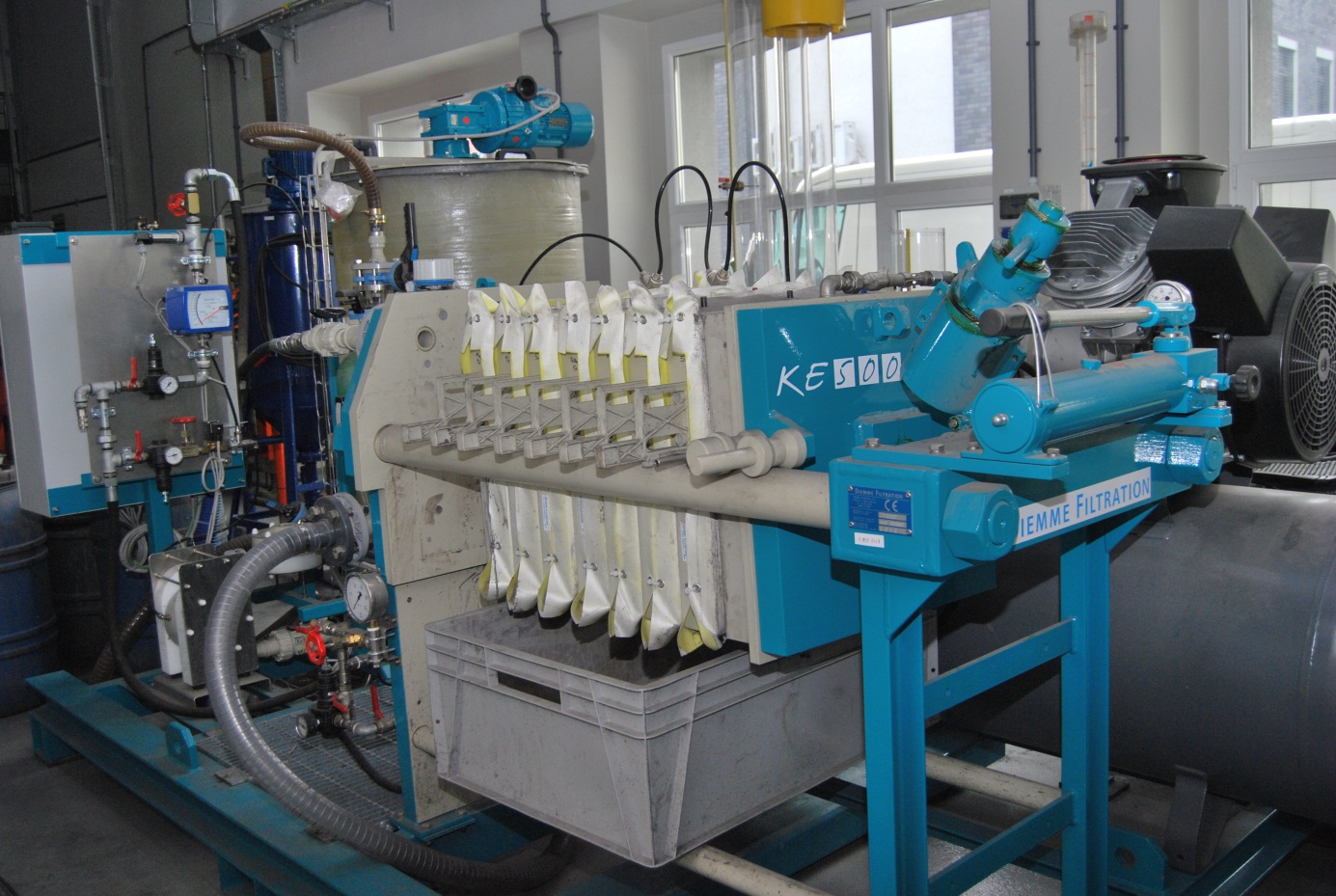 | 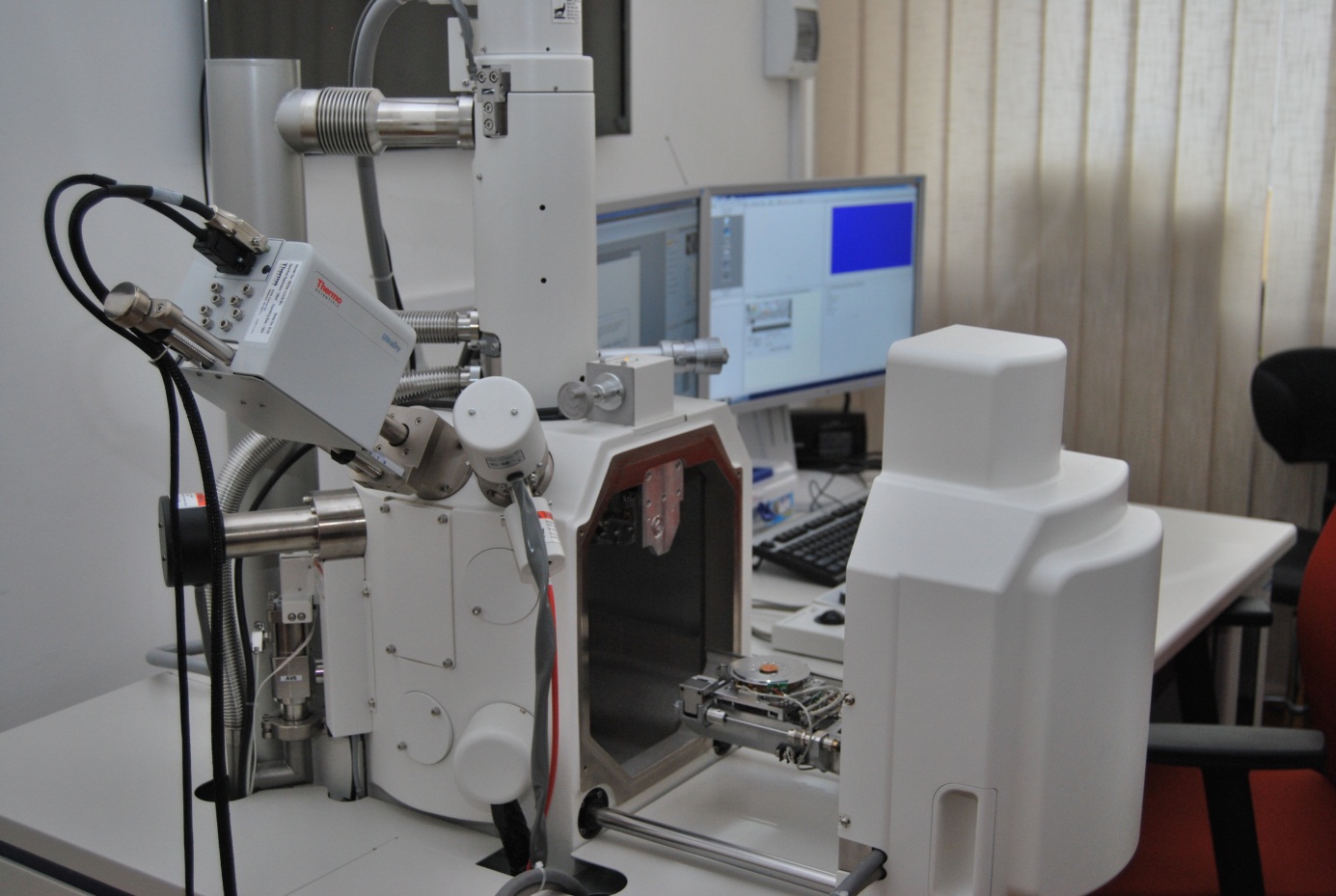 |  |
The technical equipment in the Laboratory and the staff experience allow testing and optimization of various industrial unit processes on a laboratory scale. We have the technical capabilities to carry out verification tests of suspension dewatering processes in a sedimentation-filtration centrifuge and a chamber-membrane press with blowing, on a full industrial scale.
We develop and consult concepts of technologies for the enrichment of mineral raw materials, instructions for running landfills, expertise in achieving the assumed ecological effects of investments, as well as tools and instruments supporting waste management.
We also deal with active social and labour market policy, strategic directions of development of communes and counties of the Silesian Voivodeship, demographic conditions of social policy, etc.
Jednostka Oceny Zgodności


